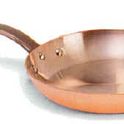what's the best way to store bread?
38 Comments
luvcookbooksJanuary 27, 2016
My mom, who baked all of our bread, had a bread drawer in the kitchen. It's like a built in bread box. Metal with a sliding top that had a few vent holes. The bread seemed very happy there and did not stale. We ate it so fast that it never molded, maybe it didn't have the chance to stale, either. When she did resort to buying store bought bread (she had severe hepatitis A), we bought the plastic bags and the sliced loaves stayed in the plastic bags on the counter.
mid-rare79November 3, 2012
Freezer, I know it sounds anti-intuitive. Freezer dry, bread moist, wouldn't work right? Wrong. I put all my stuff there now, my insane mother got me doing it. Bagels, fresh baked bread. This week I took a challah roll that Lenny's on the UWS gave me as a bonus. Made a mortadella and pastrami sandwich with basil and tomato, was quite possibly the best sandwich I've ever had and the bread was at the forefront.
chef O.July 13, 2012
If you are not freezing it for long term storage then put it in a paper bag and stick it in a bread bin. It will keep for several days.
petitbleuApril 27, 2012
Everyone is so opinionated about bread storage. It's interesting to see the different responses. As a bread baker, I am heavily invested in keeping my loaves fresh. Since it's just the two of us, and we can't go through a loaf, or sometimes even half a loaf, in a few days, I store my bread in a gallon plastic bag at room temperature. Anything I know we won't be able to eat before it molds goes in the freezer.
As much as I know that I should probably keep my bread in a paper bag or a cloth towel, I've had way too many loaves go stale before their time when stored this way. Besides, since I toast almost all the bread I eat, it comes out just fine even when stored in plastic.
As much as I know that I should probably keep my bread in a paper bag or a cloth towel, I've had way too many loaves go stale before their time when stored this way. Besides, since I toast almost all the bread I eat, it comes out just fine even when stored in plastic.
Elaine R.April 27, 2012
If you are talking about good artisan bread - never put it in the frig and never store it in plastic.
Wrap the bread in a clean linnen cloth and store on the counter. If the loaf is too big to use up in3 or 4 days, freeze part of it for another time.
Wrap the bread in a clean linnen cloth and store on the counter. If the loaf is too big to use up in3 or 4 days, freeze part of it for another time.
GIOVANNI50February 19, 2012
After I get home and use what I need, I immediately cut the bread into reasonable size pieces (like for panini or crostini), I put in a Ziplock bag (large one) and put in freezer. The water content remains frozen and intact. When ready to use, I take what I need and put in microwave for VERY LITTLE time say 15 seconds or so. Bread comes out as if fresh, no "gummyness" or rubbery feel because of the, again, VERY SHORT microwave time. Works every time.
Devangi R.February 19, 2012
Where can I buy bread bag.. I meant cotton bag...
JenSJanuary 11, 2012
I bought a great little organic cotton drawstring bag to keep bread in at Iggy's Bread in Cambridge, MA. Keeps the crumb protected from too much air but breathes to keep the crust nice.
Steve O.December 25, 2011
Never store bread in the fridge unless you intend to eat it toasted or grilled.
boulangereNovember 30, 2011
When I lived in San Francisco, I could easily go the cotton-bread-bag-on-the-counter route (until we got our first dog). Here in Montana, where the air is dry 12 months out of the year, I reluctantly go to a plastic bag in the bread box, an "antique" from England that I got from an antique store going-out-of-business sale in Walnut Creek, CA probably 25 years ago; I says BREAD on one side just in case I forget from one day to the next where I've put the stuff. I have to bungee-cord it closed because, you see, I have 2 border collies who, if I didn't turn off the wireless internet connection during the day when I'm gone, would be on the internet to bungee.com seeing how to breech the security. I digress. The fridge is the worst place for bread, or any other baked goods (save for an iced cake which is another story for another day). Refrigeration is a naturally dehydrating environment. At temps below 40 degrees, and I sincerely hope that your fridge cools to below 40 degrees, starch molecules begin to break down. In doing so, they shed their water molecules. While it is true that bread in a refrigerator will be late to mold because of its loss of moisture, it will also be late to be fresh for the same reason. ShirleyAnn and I are cutting or portioning our loaves of bread in half. One half goes into a plastic bag and into the bread bin, while the other is double-wrapped in plastic and frozen.
scruzOctober 6, 2017
wow, i knew them collies were smart, but that is frightening!
'Shirley,AnnNovember 30, 2011
Wrap it well so it doesn't get freezer burn and put it in the freezer.
bigpanNovember 28, 2011
I use a cotton bread bag and leave on the countertop.
debbietJanuary 2, 2011
I also store my home-baked bread upside down on the cutting board.
I bake slow-(cold) fermented whole grain bread, so it stays fresher on the counter for days.
I bake slow-(cold) fermented whole grain bread, so it stays fresher on the counter for days.
usuba D.November 24, 2010
Still have the original microwave I got as a wedding present over 30 years ago . . never have used it, but it makes a great bread box!
spiffypawsNovember 10, 2010
In a bread box. Or loosely wrapped in the plastic bag-it needs some air.
GeepersNovember 8, 2010
the best way to store bread is in your stomach -- other than that wrap it tightly and freeze it.
iuzziniOctober 14, 2010
If it's fresh we often stick the leftover piece, cut side down, in a le creuset (the heavy lid keeps it fresh for several days) and then just reheat it in the oven to recrisp it- If it's already sliced we freeze it and then toast before using. But- like thirschfeld- if it gets away from us (as in the case of a recent baguette we made) we turn stale bread to crumbs, french toast, bread pudding, stuffing, soup croutons, bread salad . . .
AntoniaJamesSeptember 8, 2010
I'm with Mr. Hirschfeld on this, all the way. My bread, after cooled, goes into a plastic bag with a twist tie and kept at room temperature. If it's not eaten after two days (rare here), it's put to another use, i.e., incorporated into a recipe and put onto the table at a meal within a day or so.
betteireneSeptember 8, 2010
What kind of bread--whole loaves or sliced? Whether homemade or store-bought, if it's an unsliced loaf, do what cookbookchick says. If it's sliced, freeze it after two days. If the slices haven't been smushed into each other, they're easy to separate while frozen.
cookbookchickSeptember 8, 2010
(And I agree with those who say that the fridge is the worst place to store bread! Divide the loaf and freeze it, tightly wrapped of course, if you have more than you can consume in a day or two.)
cookbookchickSeptember 8, 2010
When I bake bread, I put the cut side down on the cutting board and leave it there uncovered. The crust stays crusty and the crumb stays fresh -- for at least a couple of days -- and the bread does not get moldy. When whatever bread is left does turn stale, it's breadcrumb time! Plastic bags promote the growth of mold by sealing in moisture and they ruin a good crust.
thirschfeldSeptember 8, 2010
what ever I don't use after three days gets turned into bread crumbs. The reality is bread is best on baking day, after that it is stored in a plastic bread bag at room temp. After three days it gets broken into bits and dried for bread crumbs and to go back into home made bread. Yes you can bake great bread by mixing in bread crumbs. It is a great way to use them up and it gives the bread great flavor.
purvisjoFebruary 19, 2012
How do you make bread using bread crumbs? I can't find a recipe like that & would be really interested in the actual recipe.
AntoniaJamesFebruary 19, 2012
Here's such a bread recipe, which I posted here: http://www.food52.com/recipes... Incidentally, it was chosen as a winner by The New York Times in their "your signature potluck dish " contest a month or two after I posted it here. ;o)
drbabsSeptember 8, 2010
@sygzy, yes, you're right if you're going to use the bread right away. But if, like me, there are 2 people in your household and you don't eat much bread, the freezer works reasonably well.
sygyzySeptember 7, 2010
The best way to store bread is in a bread box or at least in an area with little active air-flow as to note promote drying. If it's something like a French baguette, fold over the excess paper and maybe seal with a rubber band. The last place to store bread is in a refrigerator or freezer. That's just gross and Amanda Hesser does not do gross.
MyCommunalTableSeptember 6, 2010
My uncle, the baker, says the frig is the last place you should put your bread. The frig is the perfect moisture to stale bread and it changes its flavor. Keep it at room temp, such as bread bin, or put in freezer tightly wrapped twice is what he recommends and I have found it to be true.
Merrill S.September 6, 2010
Once I've used it fresh for the first time, I often put my bread in the refrigerator, wrapped up -- just to make sure it doesn't get moldy. But my mother has a bread bin (made of stainless steel, I think) that seems to keep hers relatively fresh for several days.
Showing 38 out of 38 Comments
Recommended by Food52
Popular on Food52
Continue After Advertisement













